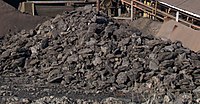
Photo from wikipedia
Abstract Magnetic Zn/Al layered double hydroxides (M Zn/Al LDH) were prepared by co-precipitation method and then calcined at 370 °C for 2 h to obtain magnetic Zn/Al calcined layered double hydroxides (M… Click to show full abstract
Abstract Magnetic Zn/Al layered double hydroxides (M Zn/Al LDH) were prepared by co-precipitation method and then calcined at 370 °C for 2 h to obtain magnetic Zn/Al calcined layered double hydroxides (M Zn/Al CLDH) used for adsorption of humic acid (HA) from aqueous solution. The morphology and structure of M Zn/Al CLDH were characterized by scanning electron microscope (SEM), X-ray diffraction (XRD), Fourier transform infrared spectroscopy (FTIR), specific surface area (SSA), thermogravimetric analysis and differential scanning calorimetry (TG-DSC) and vibrating-sample magnetometer (VSM), respectively. The results showed that the implant of a certain amount of magnetic substrates on Zn/Al LDH didn't damage the layered structure of Zn/Al LDH. After calcination, M Zn/Al CLDH exhibited the characteristics of zinc aluminum oxides, whose specific surface area increased to 80.00m2/g from 49.15 m2/g of M Zn/Al LDH. The magnetism of M Zn/Al LDH originating from Fe3O4 and γ-Fe2O3 kept well under calcination at 370 °C. The influence of solution pH and competitive ions on the HA removal was investigated. M Zn/Al CLDH exhibited high HA removal efficiency which was over 97% from pH 4 to pH 8 for 30 min at M Zn/Al CLDH dosage of 0.2 g/L and HA initial concentration of 20 mg/L. The kinetic, adsorption isotherm and thermodynamic of the adsorption of HA by M Zn/Al CLDH were studied. The results indicated that the adsorption followed pseudo-second-order kinetics model and Langmuir isotherm model. Thermodynamic analysis suggested that the adsorption of humic acid on M Zn/Al CLDH was a spontaneous and endothermic process. The adsorption mechanism is associated with electrostatic interaction and the intercalation of some functional groups of HA during layered structure of M Zn/Al LDH recovery in water due to the memory effect. This study revealed that M Zn/Al CLDH was an effective adsorbent for HA removal in water treatment.
Journal Title: Applied Clay Science
Year Published: 2020
Link to full text (if available)
Share on Social Media: Sign Up to like & get
recommendations!